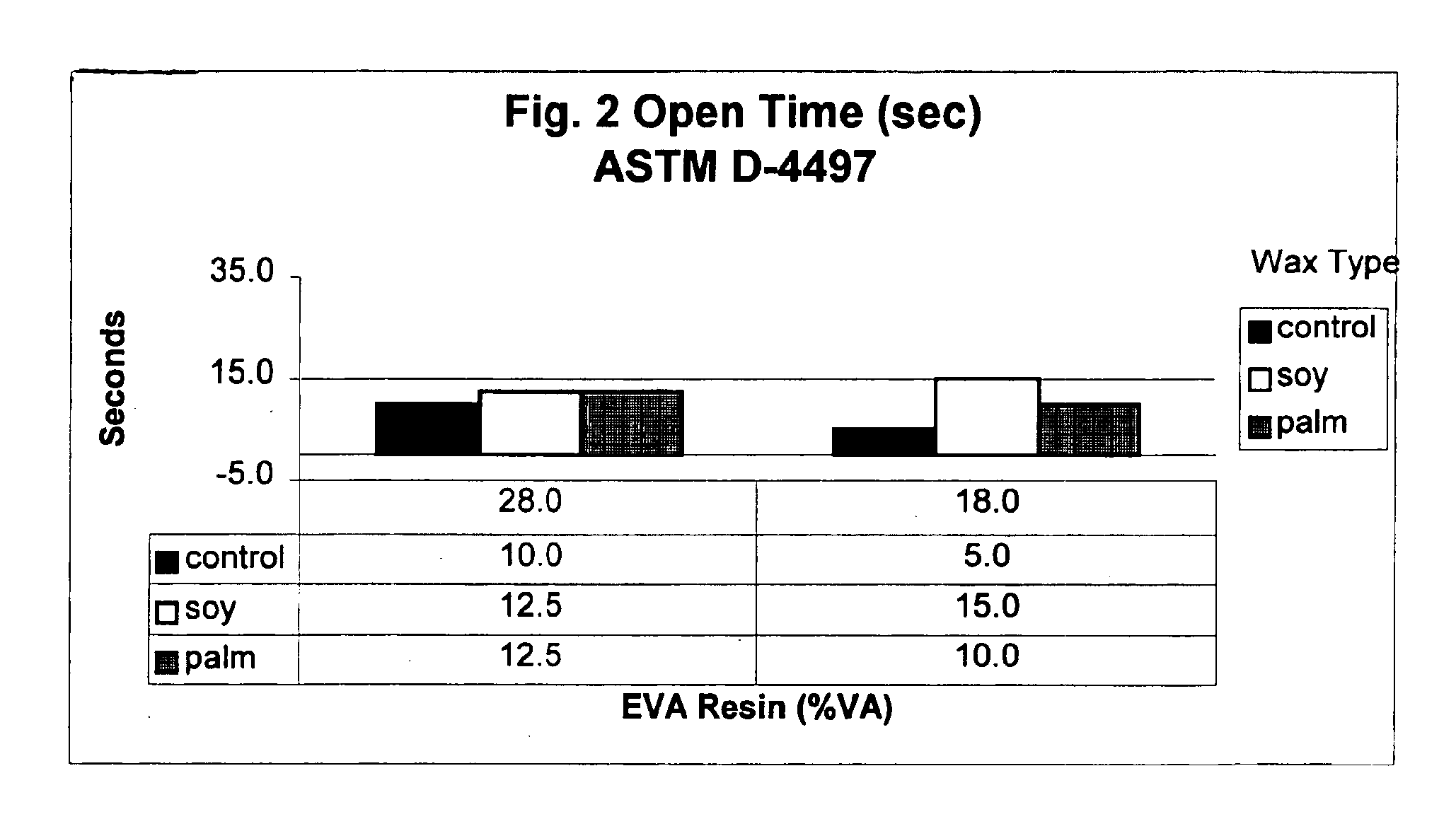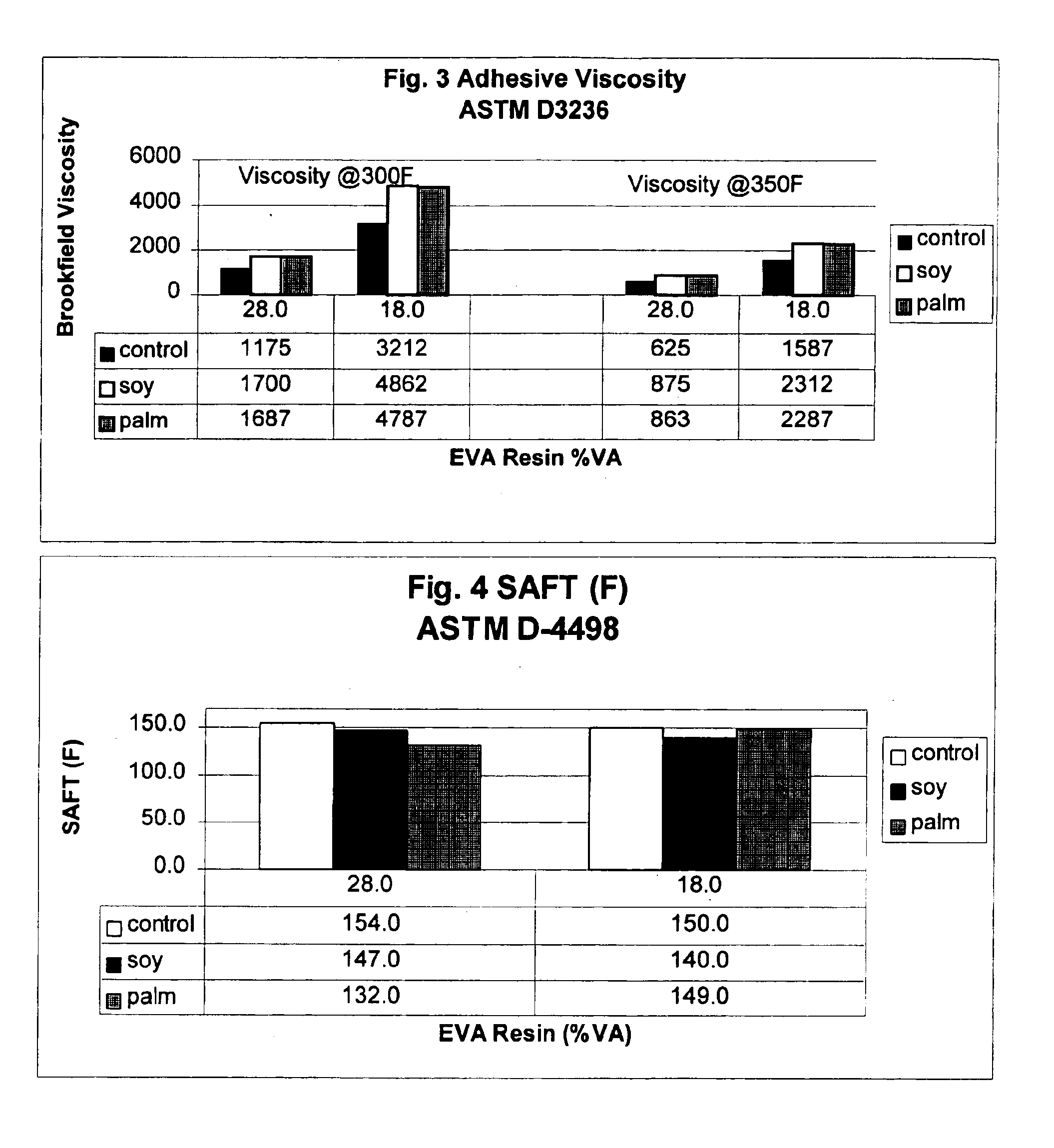Wax for hot melt adhesive applications
a hot melt adhesive and wax technology, applied in the field of vegetable wax, can solve the problems of poor adhesive performance, inability to apply adhesives, and general increase in the cost of more polar waxes, and achieve the effect of economic production
- Summary
- Abstract
- Description
- Claims
- Application Information
AI Technical Summary
Benefits of technology
Problems solved by technology
Method used
Image
Examples
example 1
Preparation and Evaluation of Adhesive Formulations
[0078]For the purpose of illustrating the invention, evaluations were conducted to determine the performance of wax material versus a ‘control’ petroleum derived microcrystalline wax in standard hot melt EVA formulations.
[0079]The following materials were used to make the EVA adhesive formulations.[0080]1. EVA resin with 18% VA content, ULTRATHENE® 612-04 made by Equistar Chemical, LP.[0081]2. EVA resin with 28% VA content, ULTRATHENE® 646-04 made by Equistar Chemicals, LP.[0082]3. Rosin Ester tackifier, FORAL® 85 made by Hercules.[0083]4. Microcrystalline Controll Wax, 1251 / 7 supplied by Frank B. Ross Co.[0084]5. Thermal stabilizer IRGANOX® 1010 made by Ciba-Geigy.
[0085]The compositions of the formulations used are in Table 4; the ingredients were added on a weight basis, and were designated as either “High VA” (indicating the use of the 28% EVA content resin), or “Low VA” (indicating the use of the 18% EVA content resin). Ingredie...
example 2
Compatibility Testing of Waxes with Adhesive Formulation Components
[0086]To determine whether the waxes were compatible with the other components of the hot melt adhesive formulations, 25 grams of adhesive were placed into a 4-ounce glass jar. The jar was placed in an oven at 350 degrees F. and the adhesive examined visually every half hour for 2 hours for evidence of phasing or incompatibility. The results showed that after 2 hours at 350 degrees F., the adhesive formulations were crystal clear and uniform in appearance, indicating that the soy and palm waxes were compatible with the other components of the adhesive formulations, in formulations having high and low VA content.
example 3
Adhesive Properties of the Inventive Formulations
[0087]To evaluate the adhesive properties of the inventive formulations, the hot melt formulations were coated onto 56# basis weight paper typically used in the manufacture of cardboard boxes. The formulations were coated at both 5 and 10 mil thickness.
[0088]Coatings were made using a wet film applicator (Bird type) with a 5 or 10 mil gap. The adhesive composition, the 4 inch wide applicator and sheets of ½ inch thick plate glass were placed into an oven for equilibration. After the appropriate time interval, the glass was removed from the oven and strips of the 56# basis weight paper, were placed onto the glass. A volume of the specific coating was placed at one end of the paper, the applicator applied to the paper and the hot molten adhesive drawn by hand to coat the paper. Equivalent coating weights were calculated as 73 g / 1000 square feet for the 5 mil coating, and 146 g / 1000 square feet for the 10 mil coating.
PUM
| Property | Measurement | Unit |
|---|---|---|
| Fraction | aaaaa | aaaaa |
| Fraction | aaaaa | aaaaa |
| Fraction | aaaaa | aaaaa |
Abstract
Description
Claims
Application Information
 Login to View More
Login to View More - R&D
- Intellectual Property
- Life Sciences
- Materials
- Tech Scout
- Unparalleled Data Quality
- Higher Quality Content
- 60% Fewer Hallucinations
Browse by: Latest US Patents, China's latest patents, Technical Efficacy Thesaurus, Application Domain, Technology Topic, Popular Technical Reports.
© 2025 PatSnap. All rights reserved.Legal|Privacy policy|Modern Slavery Act Transparency Statement|Sitemap|About US| Contact US: help@patsnap.com



